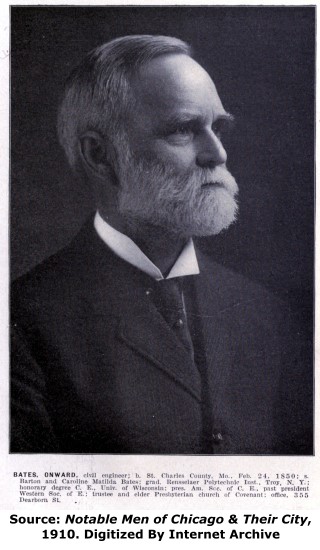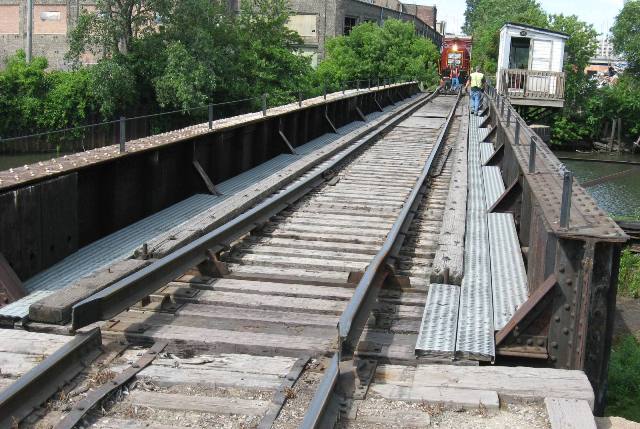We Recommend:
Bach Steel - Experts at historic truss bridge restoration.
BridgeHunter.com Phase 1 is released to the public! - Visit Now
Bridge Z-6
Milwaukee Road Bloomingdale Line Railroad Bridge

Primary Photographer(s): Nathan Holth
Bridge Documented: March 18, 2008 and April 10, 2019
Railroad (Canadian Pacific, Former Chicago, Milwaukee and St. Paul Railway) Over North Branch Chicago River
Chicago: Cook County, Illinois: United States
Metal Through Girder, Movable: Swing (Arc Bearing Bobtail) and Approach Spans: Metal Girder, Fixed
1899 By Builder/Contractor: American Bridge Works of Chicago, Illinois and Engineer/Design: Onward Bates
Not Available or Not Applicable
175.2 Feet (53.4 Meters)
245.2 Feet (74.7 Meters)
Not Available
1 Main Span(s) and 1 Approach Span(s)
Not Applicable

View Information About HSR Ratings
Bridge Documentation
View Historic American Engineering Record (HAER) Documentation For This Bridge
HAER Data Pages, HTML - HAER Data Pages, PDF
View Historical Articles Describing The Bridge Design and Construction
This adaptation of a bobtail swing bridge was originally built and owned by Chicago, Milwaukee and St. Paul Railway to replace a former wooden swing bridge at the location. The replacement plate girder bobtail swing bridge's extremely unusual design may be the only one of its kind in existence. Its unusual design is how the railroad approached the challenge of constructing a bridge at a bend in the river and where there was very little physical space.
The Chicago, Milwaukee and St. Paul Railway had a history of designing its own bridges. It was also not interested in getting into the cost and inconvenience of having to utilize a patented movable bridge design that might have been simpler and more effective from a functional standpoint. As such, even though a bascule bridge or a vertical lift bridge might have solved the space problems at the location, the railroad still decided to stick with the structure type it was familiar with designing on its own, the swing bridge, and figure out a way to fit a swing bridge into the location. This challenge was approached by the designer of the bridge, Onward Bates who was the Superintendent of Bridges and Buildings for the Chicago, Milwaukee and St. Paul Railway. The American Bridge Works of Chicago, Illinois was the fabricator of this bridge. American Bridge Works would be bought out by the similarly named American Bridge Company of New York, New York which would be formed shortly after this bridge was built, but it is important to note that these are two different companies. This is a rare surviving example of the work of the American Bridge Works.
The space problem was caused largely by the unusual location, at a sharp bend in the river, as well as the need to provide at least a 100 foot clear opening for boats, meaning that it was important to avoid placing a pier in the middle of the river. To provide the 100 foot span, while also sticking with the swing design, the railroad had to find a way to make a swing bridge work with the swing pier being placed on the eastern shore of the river. However the problem was if a traditional "symmetrical" swing bridge were placed with a pier on this shore, when such a bridge swung open, the half of the bridge which would be over land when closed would actually end up partly sticking out into the river obstructing the very boat traffic it would be opening for. This occurs only because of the manner of that sharp bend in the river. Therefore, a bobtail swing bridge was needed at this location. See below diagram.
Bobtail swing bridges were not a new technology, although in the United States they have always been far less common than the symmetrical swing bridge. However, the railroad designed this particular bobtail swing bridge in a manner that is highly unusual. Firstly, the bridge's swing span has an overall length of 175.2 feet, with a 141.5 foot cantilever out from the swing pier, yet it is a plate girder. This is an extremely long length for a plate girder span. The most unusual portion of the bridge is the swing pier. The bridge's roller nest upon which the bridge rotates does not surround the bridge in a complete circle like a normal swing bridge. Instead, two arcs opposite from each other with roller nests are present to allow the bridge to swing. This design is possible largely because the angle of the river as well as the railroad line means that the bridge does not need to rotate a full 90 degrees. Another unusual feature of the bearing design is that the dead weight of the bridge is not equally distributed to each of these arcs, instead most of the weight is placed upon the arc under which the longer cantilevered section extends over. In this way, the bridge is similar to a rim-bearing swing bridge but their is no circular "rim" but instead the two arcs, with the dead weight being unevenly distributed to these arcs.
Onward Bates apparently outgrew his position with the railway and by 1902 had formed his own company, Roger and Bates Construction Company. Little is known about the partner, Rogers, but it appears that a son named Lester C. Rogers ran the company as president since 1937 after having been an engineer and vice president for the company. The company was still active with Lester Rogers as president in 1953. The company constructed the Tidioute Bridge in Pennsylvania in 1933.
Above: An advertisement for the American Bridge Company of Chicago, a couple decades before Bridge Z-6 was built. This company appears to have later renamed itself to to American Bridge Works. Egan Avenue is a street that has either been renamed or removed, and appears to have been near 40th Street. Note that this American Bridge Company is completely different from the more familiar American Bridge Company of New York, New York that was formed in 1900.
![]()
Historic Bridges of Chicago and Cook County


Chicago and Cook County are home to one of the largest collections of historic bridges in the country, and no other city in the world has more movable bridges. HistoricBridges.org is proud to offer the most extensive coverage of historic Chicago bridges on the Internet.
General Chicago / Cook County Bridge Resources
Chicago's Bridges - By Nathan Holth, author of HistoricBridges.org, this book provides a discussion of the history of Chicago's movable bridges, and includes a virtual tour discussing all movable bridges remaining in Chicago today. Despite this broad coverage, the book is presented in a compact format that is easy to take with you and carry around for reference on a visit to Chicago. The book includes dozens of full color photos. Only $9.95 U.S! ($11.95 Canadian). Order Now Direct From The Publisher! or order on Amazon.
Chicago River Bridges - By Patrick T. McBriarty, this is a great companion to Holth's book shown above. This much larger book offers an extremely in-depth exploration of Chicago's movable highway bridges, including many crossings that have not existed for many years. Order Now Direct From The Publisher! or order on Amazon.
View Historic American Engineering Record (HAER) Overview of Chicago Bascule Bridges (HAER Data Pages, PDF)
Chicago Loop Bridges - Chicago Loop Bridges is another website on the Internet that is a great companion to the HistoricBridges.org coverage of the 18 movable bridges within the Chicago Loop. This website includes additional information such as connections to popular culture, overview discussions and essays about Chicago's movable bridges, additional videos, and current news and events relating to the bridges.
Additional Online Articles and Resources - This page is a large gathering of interesting articles and resources that HistoricBridges.org has uncovered during research, but which were not specific to a particular bridge listing.
![]()
Photo Galleries and Videos: Bridge Z-6
2019 Bridge Photo-Documentation
Original / Full Size PhotosA collection of overview and detail photos. This gallery offers photos in the highest available resolution and file size in a touch-friendly popup viewer.
Alternatively, Browse Without Using Viewer
![]()
2019 Bridge Photo-Documentation
Mobile Optimized PhotosA collection of overview and detail photos. This gallery features data-friendly, fast-loading photos in a touch-friendly popup viewer.
Alternatively, Browse Without Using Viewer
![]()
2008 Bridge Photo-Documentation By Don Sadecki
Original / Full Size PhotosA collection of overview and detail photos. This gallery offers photos in the highest available resolution and file size in a touch-friendly popup viewer.
Alternatively, Browse Without Using Viewer
![]()
2008 Bridge Photo-Documentation By Don Sadecki
Mobile Optimized PhotosA collection of overview and detail photos. This gallery features data-friendly, fast-loading photos in a touch-friendly popup viewer.
Alternatively, Browse Without Using Viewer
![]()
Maps and Links: Bridge Z-6
Coordinates (Latitude, Longitude):
Search For Additional Bridge Listings:
Bridgehunter.com: View listed bridges within 0.5 miles (0.8 kilometers) of this bridge.
Bridgehunter.com: View listed bridges within 10 miles (16 kilometers) of this bridge.
Additional Maps:
Google Streetview (If Available)
GeoHack (Additional Links and Coordinates)
Apple Maps (Via DuckDuckGo Search)
Apple Maps (Apple devices only)
Android: Open Location In Your Map or GPS App
Flickr Gallery (Find Nearby Photos)
Wikimedia Commons (Find Nearby Photos)
Directions Via Sygic For Android
Directions Via Sygic For iOS and Android Dolphin Browser
USGS National Map (United States Only)
Historical USGS Topo Maps (United States Only)
Historic Aerials (United States Only)
CalTopo Maps (United States Only)












